Belhurst Castle History
The property that surrounds Belhurst Castle was originally the site of a Seneca Indian village and home to the Council of the Six nations of Iroquois. In the early 18th century, the land became part of the state of Massachusetts and was purchased by two 18th century land developers in the spring of 1738. The land was again sold to a group of businessmen in 1810. These men built and operated Ontario Glass Manufacturing Company, the first glass company west of Albany. In May of 1824, the land was divided among the stockholders of the Ontario Glass Manufacturing Company, and William DeLong received the largest and most desirable portion of land, which is the area that is now home to Belhurst Castle.
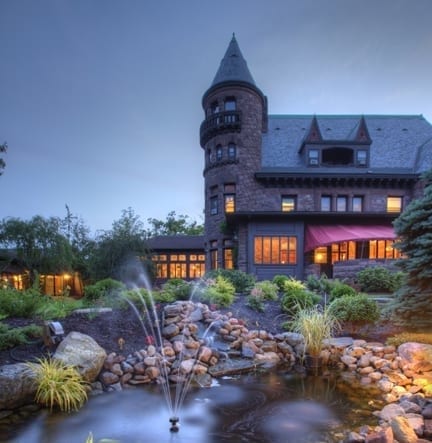 Mr. DeLong quickly sold the parcel of land to Joseph Fellows, a lawyer who was a native of Warwickshire, England. Mr. Fellows came to Geneva in 1820 as a sub-agent in the area. Ten years after his acquisition of the property, Mr. Fellows built the first “modern” residence on the land called the “Hermitage,” but never resided in the home. Instead, William Henry Bucke lived there under a deed of trust. Mr. Bucke used the alias Henry Hall, but most people in the area knew him as Bucke Hall. Because of his desire for seclusion, he lived in the “Hermitage” alone, except for one servant. In the spring of 1836, Hall fell over an obstruction and broke his leg. Hall did not seek medical treatment and died of blood poisoning a short time later. Upon his death, it was learned that William Henry Bucke had been treasurer of the famed Covent Garden Theater in London. He had embezzled theater funds, married his stepmother, fled to the United States and assumed the name Henry Hall in an effort to avoid capture!
Mr. DeLong quickly sold the parcel of land to Joseph Fellows, a lawyer who was a native of Warwickshire, England. Mr. Fellows came to Geneva in 1820 as a sub-agent in the area. Ten years after his acquisition of the property, Mr. Fellows built the first “modern” residence on the land called the “Hermitage,” but never resided in the home. Instead, William Henry Bucke lived there under a deed of trust. Mr. Bucke used the alias Henry Hall, but most people in the area knew him as Bucke Hall. Because of his desire for seclusion, he lived in the “Hermitage” alone, except for one servant. In the spring of 1836, Hall fell over an obstruction and broke his leg. Hall did not seek medical treatment and died of blood poisoning a short time later. Upon his death, it was learned that William Henry Bucke had been treasurer of the famed Covent Garden Theater in London. He had embezzled theater funds, married his stepmother, fled to the United States and assumed the name Henry Hall in an effort to avoid capture!
From the time of Hall’s death until 1852, the property changed hands twice and was then purchased by Harrison G. Otis on November 10, 1852. It was Otis that named the property “Bellehurst,” meaning beautiful forest. Over the years, the property changed hands within the Otis family and on February 28, 1877, Mary Otis sold a strip of land along the lake to the Syracuse, Geneva & Corning Railroad Company. Mrs. Otis made the railroad company agree to maintain and preserve a right of way across the tracks so that she could have access to the lake. The railroad company is still obligated to comply with the agreement made with Mary Otis more than 130 years ago.
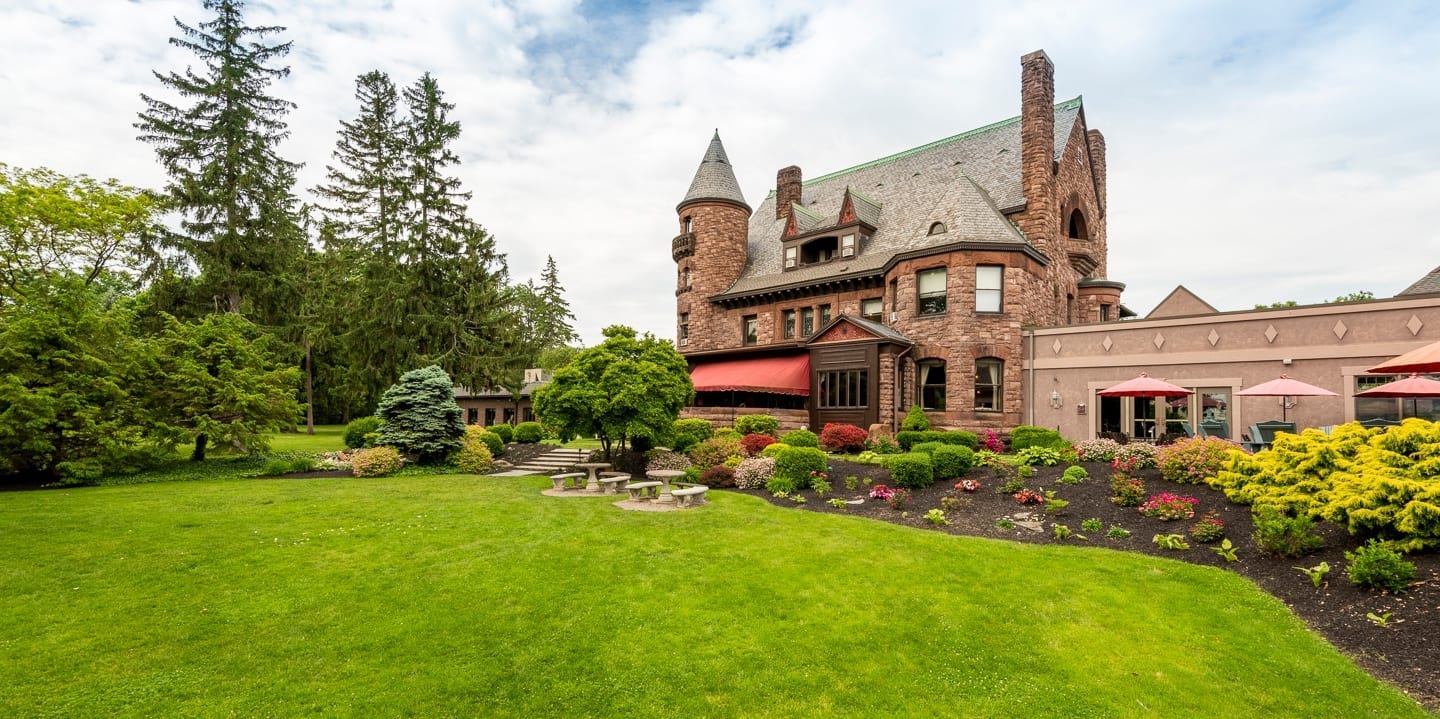 In 1878, the property, along with the land that is now Glenwood Cemetery, was taken over by the United States Trust Company, and the Otis family relocated to Virginia. The property remained vacant for seven years. During this time it was known as “Otis Grove,” a popular picnic area for the residents of Geneva. The “Hermitage” was still located on the property and it was rumored that the house was haunted. Many believed there was an escape tunnel built by Bucke Hall as a means of escape if the authorities found him.
In 1878, the property, along with the land that is now Glenwood Cemetery, was taken over by the United States Trust Company, and the Otis family relocated to Virginia. The property remained vacant for seven years. During this time it was known as “Otis Grove,” a popular picnic area for the residents of Geneva. The “Hermitage” was still located on the property and it was rumored that the house was haunted. Many believed there was an escape tunnel built by Bucke Hall as a means of escape if the authorities found him.
On May 13, 1885, Mrs. Carrie M. Young Harron, wife of Samual V. Harron of New York City, came to Geneva, inspected “Otis Grove,” asked the price, and purchased the property that very day! After purchasing “Bellehurst,” Mrs. Harron moved to Geneva, accompanied by her manager, captain Louis Dell Collins, a native of Rose, New York, while her husband remained in New York City. Shortly after arriving in Geneva, Mrs. Harron divorced her husband, and on June 6, 1888 married Captain Collins. In the spring of 1888, Mrs. Collins had the dilapidated house that the Otis family lived in torn down in preparation for the four-story mansion she was building.
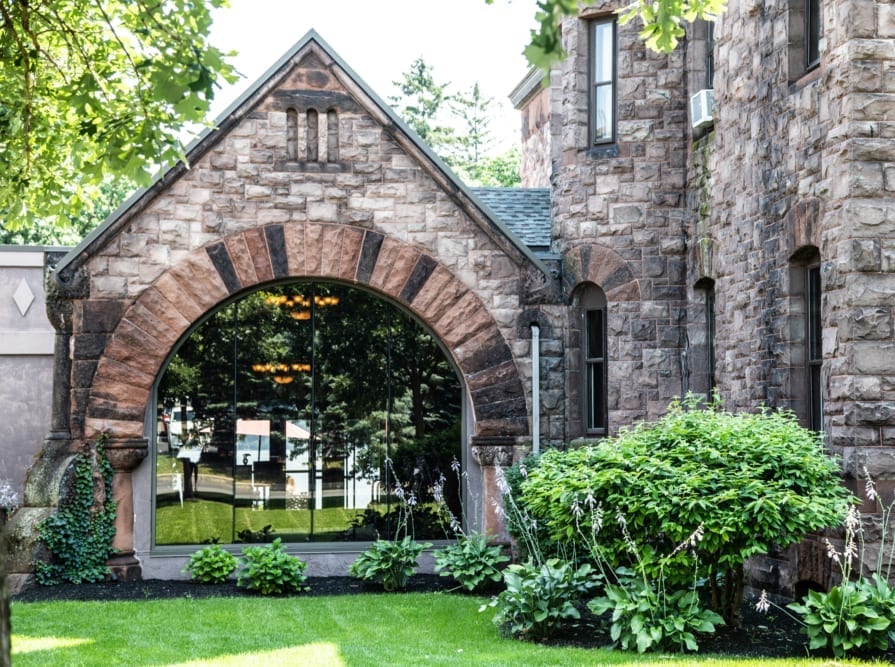 Fifty men worked for four years on the construction of Belhurst Castle. During this time, one man was killed when he fell from the tower and another went insane while putting on the roof. All the materials used to build and furnish the castle were imported to Geneva. Many items came from Europe. During the time of construction, 1885 – 1889, there was a lot of talk among the locals about what Mrs. Collins was building on the property. A woman of her means made quite an impression on the people of Geneva. The townsfolk were all aflutter about the poultry house that was built. It was brick on the outside and plaster on the inside, heated by a Furman Steam Boiler, and had wire partitions to separate the many breeds of fowl. Mrs. Collins’ prize possession was a pair of Japanese Golden Pheasants, birds that can be seen depicted on the china in Edgar’s restaurant today.
Fifty men worked for four years on the construction of Belhurst Castle. During this time, one man was killed when he fell from the tower and another went insane while putting on the roof. All the materials used to build and furnish the castle were imported to Geneva. Many items came from Europe. During the time of construction, 1885 – 1889, there was a lot of talk among the locals about what Mrs. Collins was building on the property. A woman of her means made quite an impression on the people of Geneva. The townsfolk were all aflutter about the poultry house that was built. It was brick on the outside and plaster on the inside, heated by a Furman Steam Boiler, and had wire partitions to separate the many breeds of fowl. Mrs. Collins’ prize possession was a pair of Japanese Golden Pheasants, birds that can be seen depicted on the china in Edgar’s restaurant today.
Genevans were also impressed by the elegant boathouse built to hold a 20-passenger gasoline propelled steam yacht. Unfortunately, the boathouse was consumed by fire several years later. The fire took four days to burn completely. Upon Mrs. Collins’ death in Savannah, Georgia on April 5, 1926, Belhurst Castle passed to her grandson, Hal Harron, Jr. He lived in the house for a short time, but later leased and sold it to Cornelius J. Dwyer, a colorful and engaging man with a wide circle of friends throughout the country. Dwyer, known as “Red,” purchased Belhurst in 1932 and on April 18, 1933 opened it as a speakeasy and gambling casino. Belhurst became an outstanding showcase restaurant and casino under Red’s direction. Gambling was conducted upstairs and liquor was run down from Canada during prohibition using the canal system.
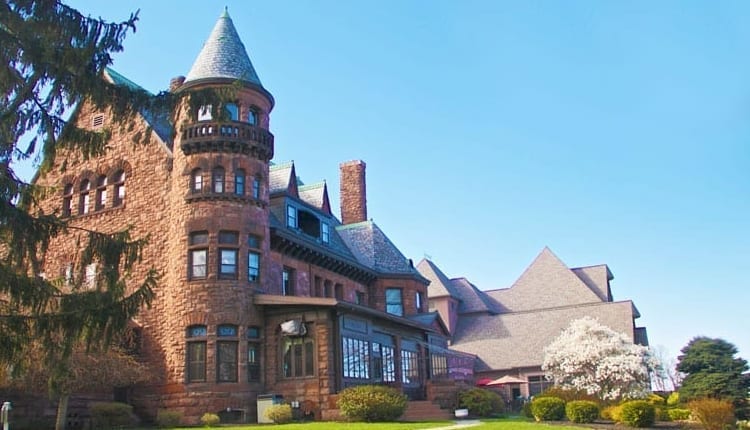 In 1952, the Kefauver Commission succeeded in convincing Red to “stop or be stopped” and the gambling days at Belhurst Castle were over. Red continued to operate Belhurst as a restaurant until 1975 when the property was purchased by Robert and Nancy Golden. The Goldens continued to run Belhurst as a restaurant while residing upstairs. Eventually, they converted the second and third floors and one out-building into twelve guest rooms and opened the premises as a hotel.
In 1952, the Kefauver Commission succeeded in convincing Red to “stop or be stopped” and the gambling days at Belhurst Castle were over. Red continued to operate Belhurst as a restaurant until 1975 when the property was purchased by Robert and Nancy Golden. The Goldens continued to run Belhurst as a restaurant while residing upstairs. Eventually, they converted the second and third floors and one out-building into twelve guest rooms and opened the premises as a hotel.
On November 2, 1992, Mr. and Mrs. Duane and Deb Reeder became the present proprietors of Belhurst Castle. A second out-building and the ranch house built in the 1950’s by Red Dwyer were converted to guest rooms. Under the direction of the Reeder’s, Belhurst became a highly-acclaimed restaurant and hotel, with the gorgeous Castle Ballroom as a popular venue for weddings and special events. In the Fall of 2003, the Reeder’s began an expansion on the Belhurst property. Construction of the 30,000 square-foot facility adjoining the 1880’s Belhurst Castle was completed and has helped Belhurst become a premier attraction in the Finger Lakes.
History of White Springs Manor
White Springs Farm, by beauty and charm alone, would be a source of pride to the town of Geneva. Its tradition of advanced and scientific farming methods firmly established it for 150 years as one of the most important agricultural enterprises in western New York State. In the early 1800’s John Nicholas, a Virginia lawyer, retired at age 47 to take up agriculture and to become the owner of this tract of land. In 1801, Nicholas bought 900 acres on the east side of Seneca Lake where Rose Hill would be built by his wife’s sister’s husband, Robert Rose. About the same time, he purchased 367 acres of the White Springs Farm.
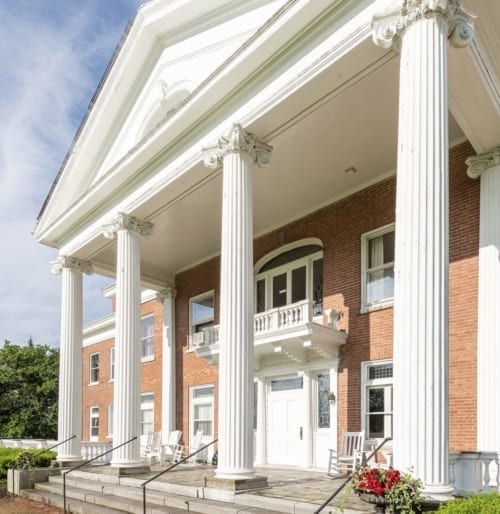
The manor house, furnished around 1806, was of colonial design: large, square, with massive fluted columns on three sides. During the lifetime of John Nicholas and his wife, Anne, holdings were expanded to 1,600 acres. He was, for several terms, a member of the State Senate and a Judge of the Court of Common Pleas of Ontario County. He specialized in sheep raising and owned 1,200 or more, doing much to promote and improve the science of sheep-husbandry. A woolen mill was built on his property. John Nicholas died in 1819. His wife Anne died in 1839. The Nicholas saga includes a long list of distinguished statesmen. The Honorable Gideon Lee, a former mayor of New York City, purchased 467 acres of the White Springs Farm in 1839, paying a little over $100 an acre. He began extensive improvements to the property but died in 1841 before they were completed. The Lee family occupied the farm for 17 years following Mr. Lee’s death. A two-story cobblestone structure built near the mansion was used as a private school as well as a tool house.
Mr. James O. Sheldon followed the Lee’s as owner of the White Springs Farm, purchasing it on January 30, 1857, for $37,500. Under his supervision, the property continued as an exhibition farm and became widely-known for the finest and most celebrated Short Horn Durham herd in the world. The mansion burned down in 1876 and the farm was sold to William and Thomas Smith. It was used as a general farm, though considerable nursery stock was raised by these brothers, who became leading nurserymen of the area. Mrs. George H. Lewis (Katherine Bell) purchased 260 acres of the White Springs Farm in 1898 for her only son, Alfred G. Lewis. The farm, which had been nearly abandoned for a quarter of a century, had a rebirth and became more beautiful.
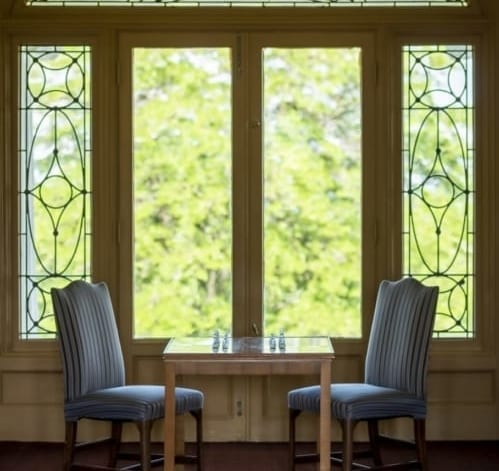
The acreage of the farm increased over a 40-year period to almost 900 acres, with the purchase of many parcels of land that had been owned by John Nicholas 100 years earlier west of Pre-Emption Road, as well as several farms on what is now White Springs Road. A white-pillared Georgian colonial mansion of red brick was erected on the original square foundation of the former home. Wide verandas gave a sweeping view of immaculate lawns, two large ponds, a gazebo and Seneca Lake valley. There were living and dining rooms, a music room, a billiard room, offices, a pantry, servants’ quarters, master bedrooms with fireplaces, four guest rooms and many baths, all finished in a gracious, but comfortable style. Other buildings on the grounds included a manager’s house, a boarding house large enough to accommodate ten men, seven magnificent barns, a coach house and an icehouse built originally as a schoolhouse. A playhouse with stone fireplaces added charm to the garden and tennis courts.
Mr. Lewis developed the largest herd of imported Guernsey cattle in the world, renewing the reputation of the White Springs Farm for stockbreeding. For 15 years, his importations from the Isle of Guernsey continued, with more than 1,100 animals in all, imported and sold at auction on the grounds of the farm. The White Springs Dairy Company was organized by Mr. Lewis in 1905, giving Genevans their first bottled milk. For many years this company was the principal supplier of milk for Geneva, New York, with a daily on-average delivery in excess of 5,000 quarts.
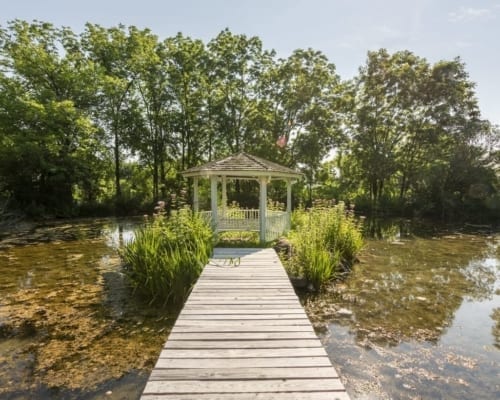
Sunday, September 1, 1912, was a day of disaster for White Springs Farm and the immediate vicinity. A cyclone wrought havoc, leveling the main group of dairy barns and uprooting most of the beautiful elms on the farm. A three-quarter-ton dinner bell from one of the barns was found a half mile away. Clean-up operations were extensive and tree experts were brought in to salvage what trees could be saved. Mr. Lewis sold the Guernseys, rather than replace the barns. By 1920 the cattle business at White Springs Farm was over. Following the demolition of the Guernsey barns, and with the dairy well established, Mr. Lewis transferred his attention to the raising of fruit. The White Springs Farm became one of the foremost fruit farms in the Northeast.
The cherry and peach orchards were the largest in the state. Acreage and number of trees in various White Springs orchards steadily increased for more than 25 years. The White Springs Farm cooperated closely with the New York State Agricultural Experiment Station, each benefiting from the other. Station scientists shared their know-how and techniques, while the farm provided a natural laboratory setting where improved and disease-resistant varieties could be developed. Mr. Willis C. Henderson, a Cornell University graduate, was farm manager from 1919-1931, helping to earn the farm its well-deserved reputation. Mr. “Newt” Campbell became the manager of the White Springs Farm around 1931 and trained Mr. Alfred Lewis, Jr. in that position. At the height of the fruit era, around 1946, as many as 550 helpers were hired each season. The extent of the fruit plantings was almost beyond imagining. There were 220 acres of cherries, with orchards bordering the majority of White Springs Road from Jay Street to Snell Road and on the east side from Jay Street to St. Clair Street.
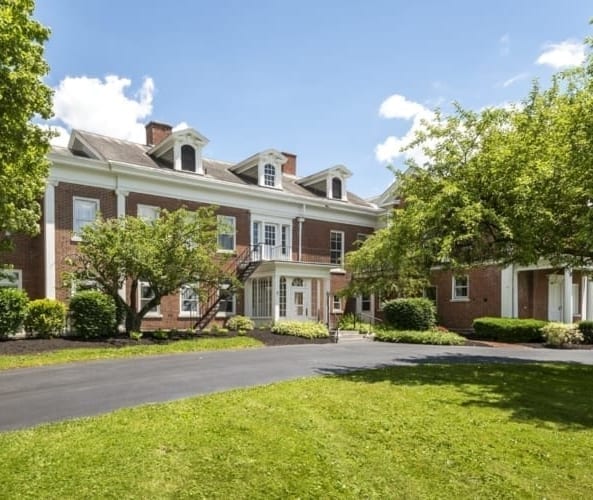
Sixty tons of fruit per hour were often picked. Apple orchards covered 79 acres. In 1946, a total of 46,000 bushels of apples (McIntosh, Rome, Wealthy) were picked annually. The peach and pear orchards extended to Hall Road along the west side of Pre-Emption Road. Eighty-seven acres of peaches, mostly Albertas, were picked and packed into two railway cars daily and shipped to New York, Baltimore, Philadelphia and elsewhere. In 1946, fifteen acres of Keifer pears produced 2,ooo bushels. White Springs Farm, under the management of Willis Henderson, was the first to dust orchards from the air, which was accomplished by helicopters. Two steam-driven tractors were operated in the 1920’s. The first farm truck was a Pierce-Arrow, a picture of which is displayed in the lower hall of White Springs Manor. Cabbage, corn, red kidney beans, snap beans, soybeans, as well as bay and wheat, were grown.
Mr. Alfred Lewis, Sr. sold land in the St. Clair Street area in 1936. From 1946 to 1972, many acres were sold for residential development. Today White Springs Road is lined on both sides with attractive modern homes. Visitors drive by slowly to absorb the beauty. White Springs Lane runs between White Springs Road and Pre-Emption Road. It is also the site of several modern homes, including White Springs Circle. In 1948 Miss Sarah Mandigo purchased the Manor house and established the Margaret Ayre Home, a proprietary home for adults, with capacity for 36 residents. The Young family purchased the property in 1980 and continued to operate it as a proprietary home until 1997 when it closed.
It was at that time that Mr. and Mrs. Duane and Deb Reeder purchased the property and opened it as a sister property to Belhurst on August 1, 1998.

